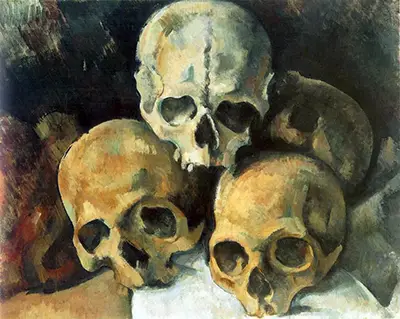From the age of around twenty-seven or so, Cezanne, already a prolific painter, was obsessed with skulls and the accoutrements of death. His first sketches and paintings of skulls are lightly sketched, almost stylised, when compared with those he did in later life, almost as though the young artist was fascinated by, and yet fearful of engaging too closely with, death.
This image, painted in later life, is exquisitely detailed, with each skull rendered with such care and skill that a reconstruction of the face is almost possible. The painting is deceptively simple: three – or is it four?* – skulls are piled upon and behind each other, upon a desk, a piece of paper seemingly caught at random underneath the bottommost two skulls, which are themselves perched precariously on the edge of the desk, overlooking a background that is mostly dark, but with hints of a richly patterned red and black carpet.
The question of the number of skulls is a simple one. Even today, in Cezanne's old studio in Aix, now a museum, the skulls used as his props in a number of paintings, along with other items that have stood the test of time (it is almost certain that any fruit or vegetables would not have lasted very long at all!), can be seen. There are three of them. Of course, Cezanne could well have borrowed a skull from someone else, drawn an imaginary skull in place, or, perhaps, used a mirror to create the impression that his pile of skulls was more substantial than it would seem to be if one was simply balanced upon two others. A graphite and watercolour rendering from shortly after the time that this painting was produced features just three skulls, with the extra space filled, this time, with a colourful piece of what seems to be floral fabric.
This 1901 painting, known as Pyramid of Skulls, painted in oil on canvas and measuring a mere 37 centimetres by 45.5 centimetres – a relatively small size for an oil painting – pays close attention to the skulls. One is forced to wonder if Cezanne was pondering the age old question of how we all look the same under the skin, and perhaps looking for differences. He may have been seeking assurances of his own uniqueness enduring after his life, after he had been reduced, in turn, into a skull and indifferent bones? Each of the skulls depicted is unique: they have differing numbers of teeth, the shapes of the eye sockets, curves of the foreheads and nasal cavities are all very different – the very bone of each skull is picked out in a different hue.
Perhaps the 'fourth' skull is representative of Cezanne's fear of disappearing into obscurity? Who can say for sure, without word from the man himself? One thing is certain. Cezanne's mother – his greatest supporter and ardent fan – passed away in 1897, just four years before this painting was created. It is with her death and the encroaching ill-health and aches and pains of age that Cezanne mastered his skittish handling of these symbols of death and began, in his work, to detail the skulls rather than placing them as stylised motifs. The painting is currently in a private collection.




